The Tokyo cityscape becomes the ultimate light show in this video for "I Will Be Here," the recent collaboration single by Dutch DJ Tiësto and Australian dance music group Sneaky Sound System. Directed by Masashi Muto.
+ Video
The Tokyo cityscape becomes the ultimate light show in this video for "I Will Be Here," the recent collaboration single by Dutch DJ Tiësto and Australian dance music group Sneaky Sound System. Directed by Masashi Muto.
+ Video
Yōkai Daizukai, an illustrated guide to yōkai authored by manga artist Shigeru Mizuki, features a collection of cutaway diagrams showing the anatomy of 85 traditional monsters from Japanese folklore (which also appear in Mizuki's GeGeGe no Kitarō anime/manga). Here are a few illustrations from the book.
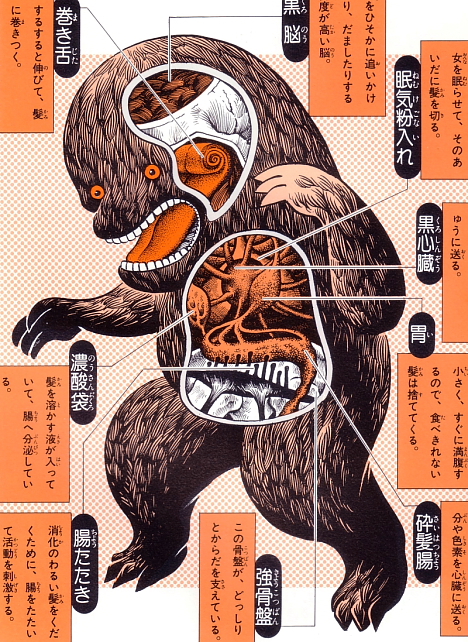
Kuro-kamikiri [+]
The Kuro-kamikiri ("black hair cutter") is a large, black-haired creature that sneaks up on women in the street at night and surreptitiously cuts off their hair. Anatomical features include a brain wired for stealth and trickery, razor-sharp claws, a long, coiling tongue covered in tiny hair-grabbing spines, and a sac for storing sleeping powder used to knock out victims. The digestive system includes an organ that produces a hair-dissolving fluid, as well as an organ with finger-like projections that thump the sides of the intestines to aid digestion.
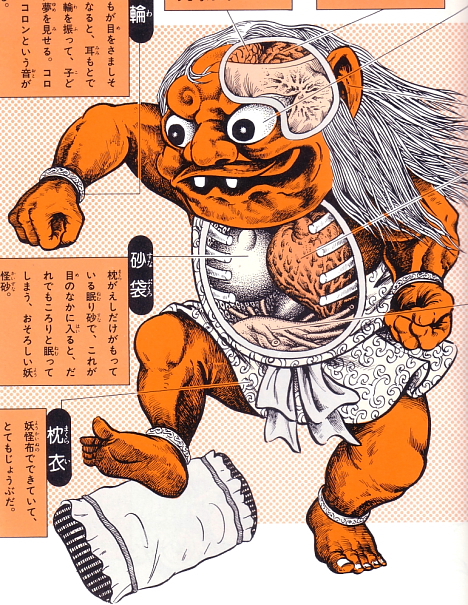
Makura-gaeshi [+]
The Makura-gaeshi ("pillow-mover") is a soul-stealing prankster known for moving pillows around while people sleep. The creature is invisible to adults and can only be seen by children. Anatomical features include an organ for storing souls stolen from children, another for converting the souls to energy and supplying it to the rest of the body, and a pouch containing magical sand that puts people to sleep when it gets in the eyes. In addition, the monster has two brains -- one for devising pranks, and one for creating rainbow-colored light that it emits through its eyes.
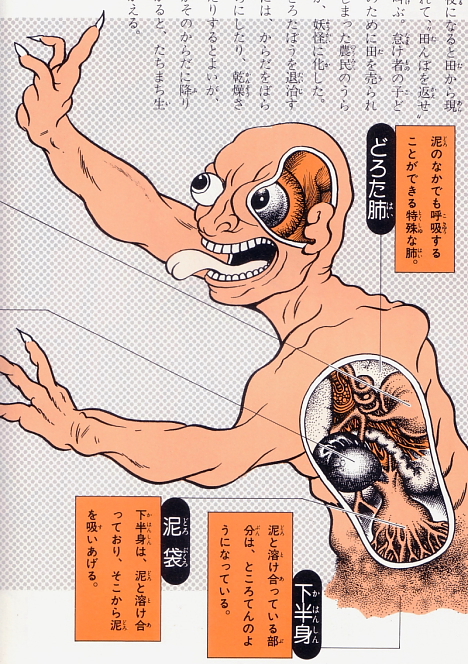
Doro-ta-bō [+]
The Doro-ta-bō ("muddy rice field man"), a monster found in muddy rice fields, is said to be the restless spirit of a hard-working farmer whose lazy son sold his land after he died. The monster is often heard yelling, "Give me back my rice field!" Anatomical features include a gelatinous lower body that merges into the earth, a 'mud sac' that draws nourishment from the soil, lungs that allow the creature to breathe when buried, and an organ that converts the Doro-ta-bō's resentment into energy that heats up his muddy spit. One eyeball remains hidden under the skin until the monster encounters the owner of the rice field, at which time the eye emerges and emits a strange, disorienting light.
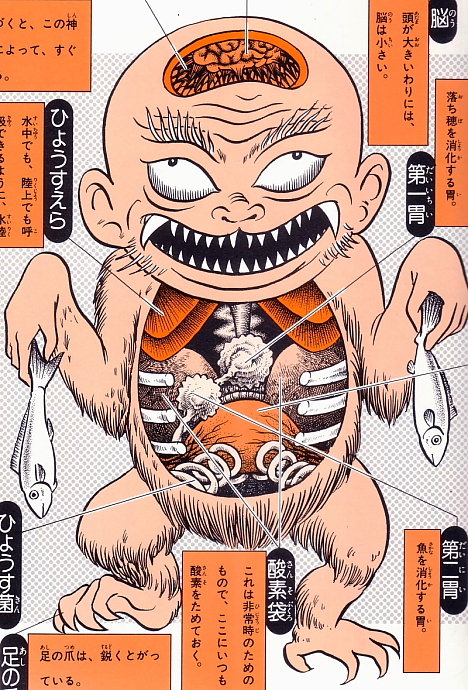
Hyōsube [+]
The Hyōsube, a child-sized river monster (a relative of the kappa) from Kyushu that lives in underwater caves, ventures onto land at night to eat rice plants. The monster has a relatively small brain, a nervous system specialized in detecting the presence of humans, thick rubbery skin, sharp claws, two small stomachs (one for rice grains and one for fish), a large sac for storing surplus food, and two large oxygen sacs for emergency use. A pair of rotating bone coils produce an illness-inducing bacteria that the monster sprinkles on unsuspecting humans.
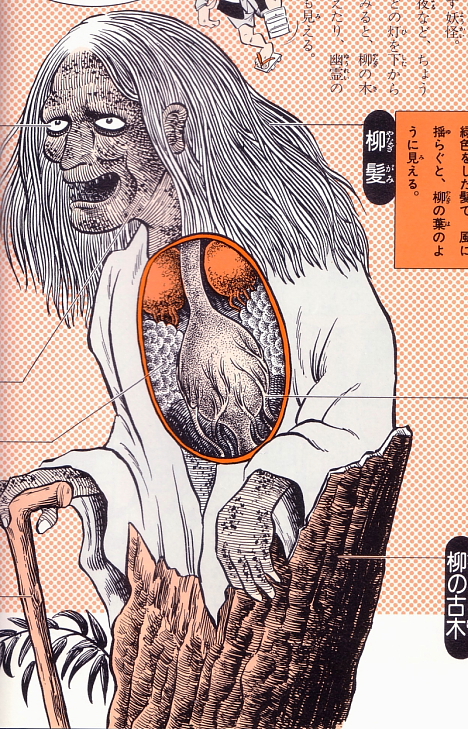
Yanagi-baba [+]
Yanagi-baba ("willow witch") is the spirit of 1,000-year-old willow tree. Anatomical features include long, green hair resembling leafy willow branches, wrinkled bark-like skin, a stomach that supplies nourishment directly to the tree roots, a sac for storing tree sap, and a cane cut from the wood of the old tree. Although Yanagi-baba is relatively harmless, she is known to harass passersby by snatching umbrellas into her hair, blowing fog out through her nose, and spitting tree sap.
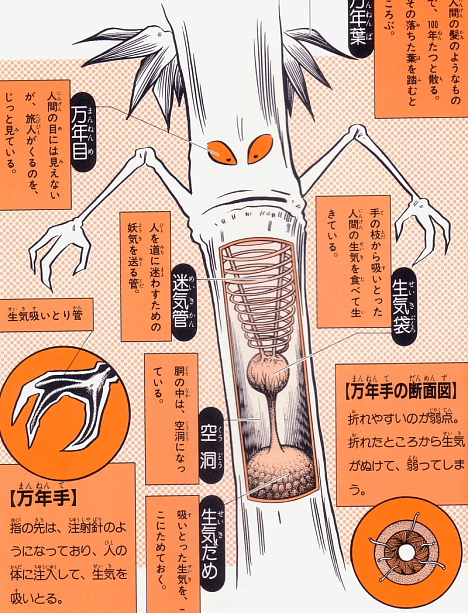
Mannen-dake [+]
The Mannen-dake ("10,000-year bamboo") is a bamboo-like monster that feeds on the souls of lost travelers camping in the woods. Anatomical features include a series of tubes that produce air that causes travelers to lose their way, syringe-like fingers the monster inserts into victims to suck out their souls, and a sac that holds the stolen souls.
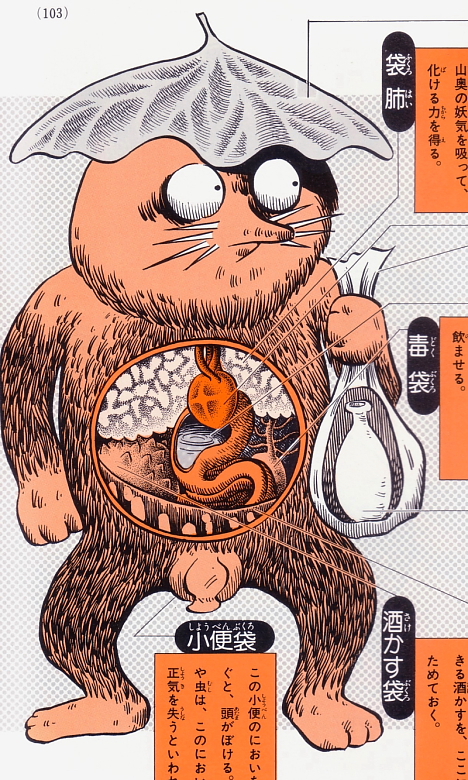
Fukuro-sage [+]
The Fukuro-sage -- a type of tanuki (raccoon dog) found in Nagano prefecture and Shikoku -- has the ability to shapeshift into a sake bottle, which is typically seen rolling down sloping streets. The bottle may pose a danger to people who try to follow it downhill, as it may lead them off a cliff or into a ditch. The Fukuro-sage usually wears a large potato leaf or fern leaf on its head and carries a bag made from human skin. The bag contains a bottle of poison sake. Anatomical features include a stomach that turns food into sake, a sac for storing poison that it mixes into drinks, and a pouch that holds sake lees. The Fukuro-sage's urine has a powerful smell that can disorient humans and render insects and small animals unconscious.
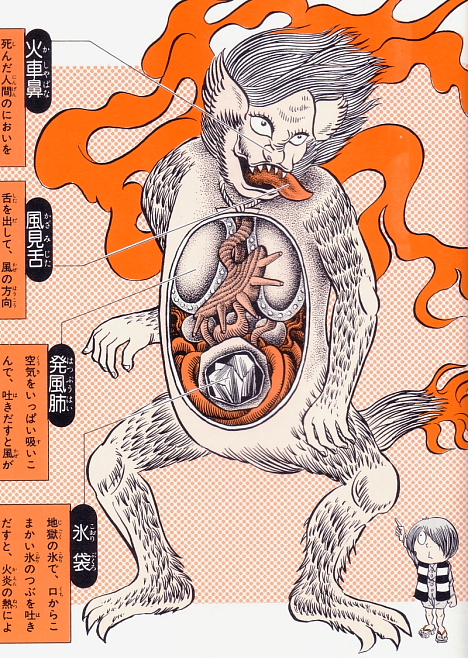
Kasha [+]
Kasha, a messenger of hell, is a fiery monster known for causing typhoons at funerals. Anatomical features include powerful lungs for generating typhoon-force winds that can lift coffins and carry the deceased away, as well as a nose for sniffing out funerals, a tongue that can detect wind direction, and a pouch containing ice from hell. To create rain, the Kasha spits chunks of this ice through its curtain of perpetual fire.
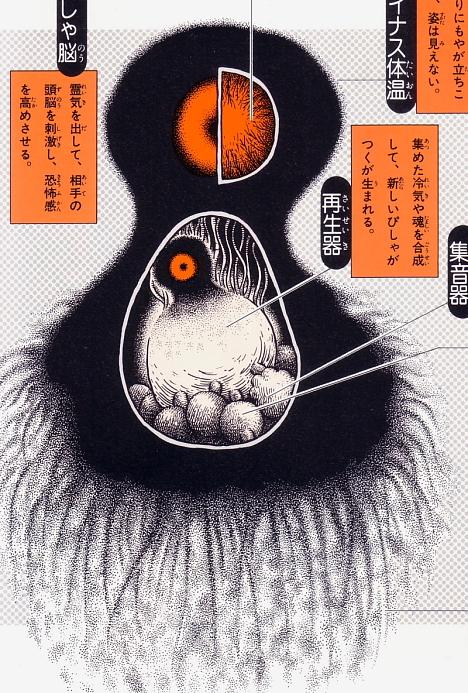
Bisha-ga-tsuku [+]
The Bisha-ga-tsuku is a soul-stealing creature encountered on dark snowy nights in northern Japan. The monster -- which maintains a body temperature of -150 degrees Celsius -- is constantly hidden behind a fog of condensation, but its presence can be detected by the characteristic wet, slushy sound ("bisha-bisha") it makes. Anatomical features include feelers that inhale human souls and cold air, a sac for storing the sounds of beating human hearts, and a brain that emits a fear-inducing aura. The Bisha-ga-tsuku reproduces by combining the stolen human souls with the cold air it inhales.
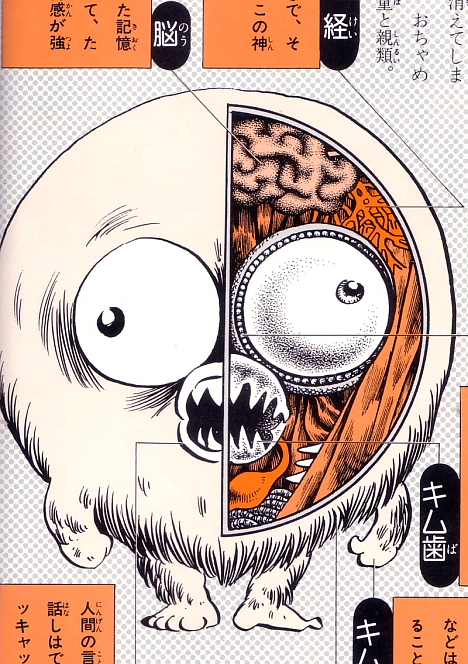
Kijimunaa [+]
The Kijimunaa is a playful forest sprite inhabiting the tops of Okinawan banyan trees. Anatomical features include eye sockets equipped with ball bearings that enable the eyeballs to spin freely, strong teeth for devouring crabs and ripping out the eyeballs of fish (a favorite snack), a coat of fur made from tree fibers, and a nervous system adapted for carrying out pranks. The Kijimunaa's brain contains vivid memories of being captured by an octopus -- the only thing it fears and hates.
[Source: Shigeru Mizuki's Yōkai Daizukai, 2004]
+ See also: Kaiju anatomical drawings
The University of Hawaii at Manoa hosts an online collection of about 1,500 magic lantern slides created in the 1930s and distributed around the world to educate people about Japan. Here are a few.
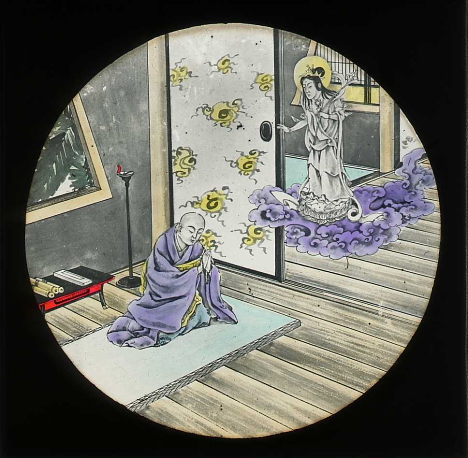
Buddhist story [+]
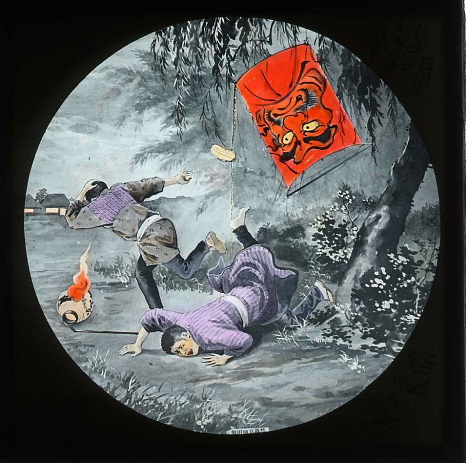
Scary kite [+]
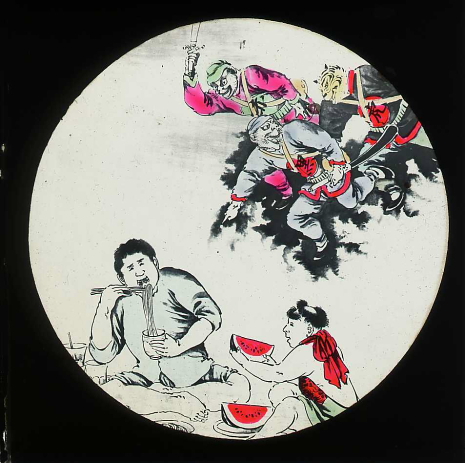
Sanitation campaign [+]
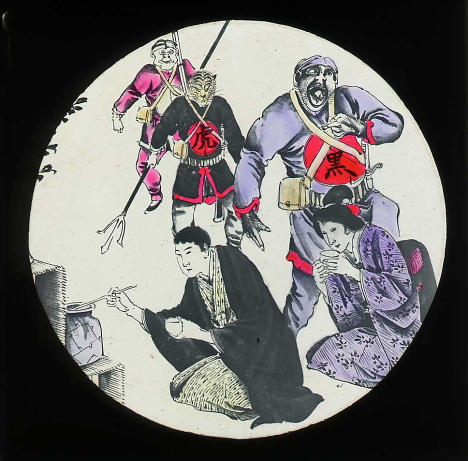
Sanitation campaign [+]
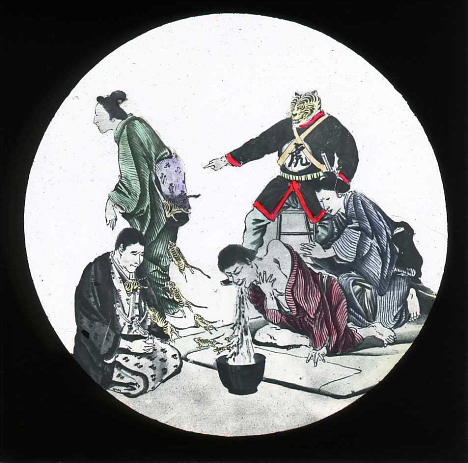
Sanitation campaign [+]
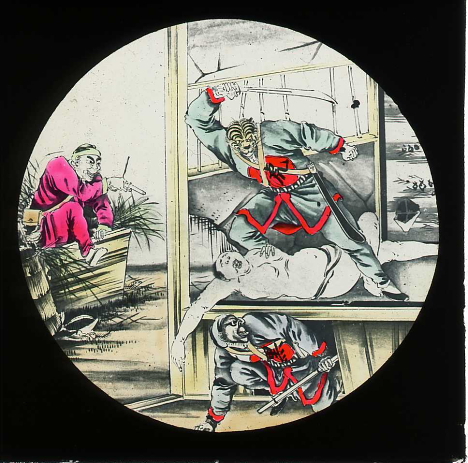
Sanitation campaign [+]
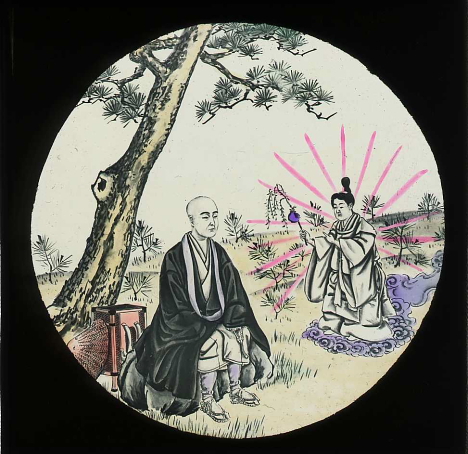
Buddhist story [+]
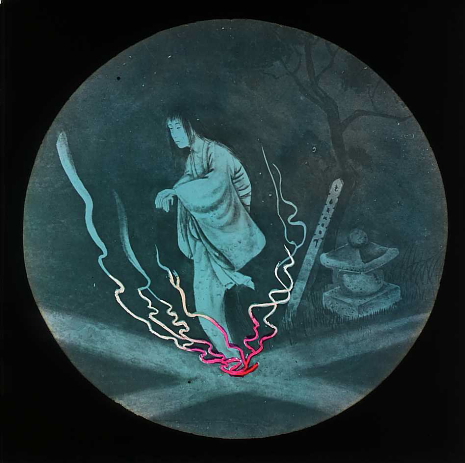
Story [+]
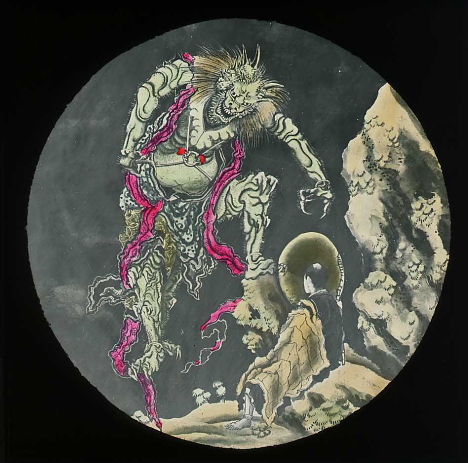
Buddhist story [+]
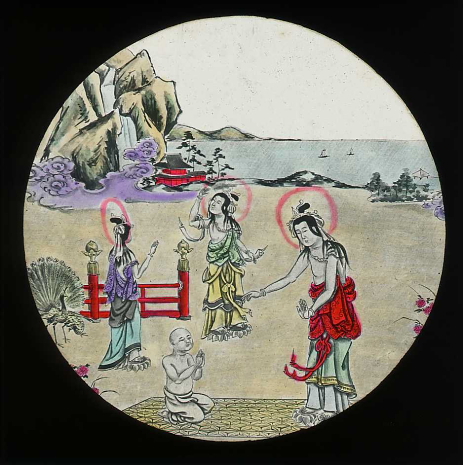
Buddhist story [+]
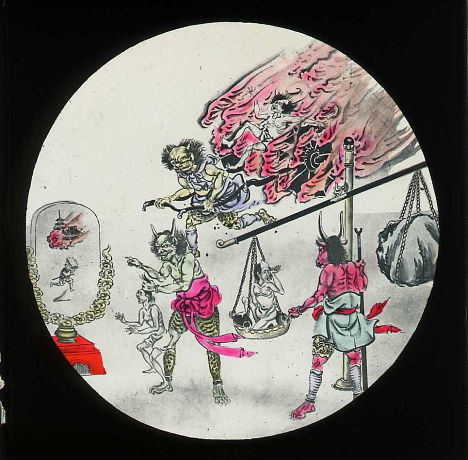
Hell [+]
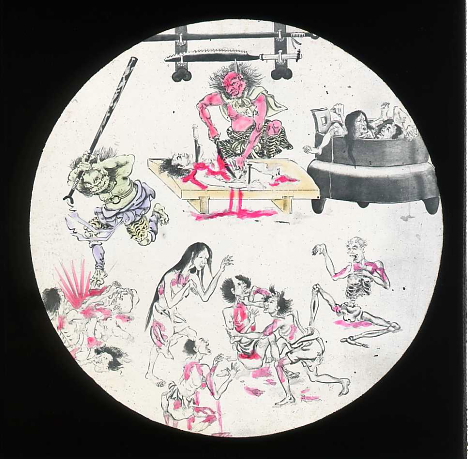
Hell [+]
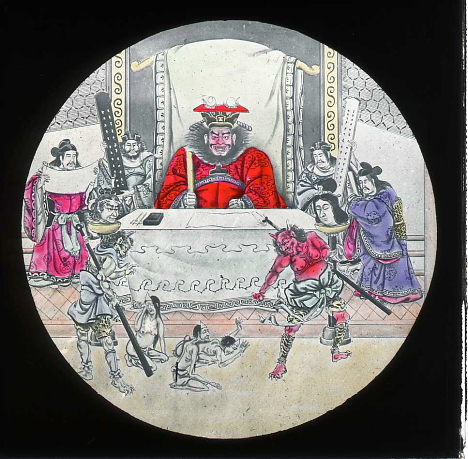
Hell [+]
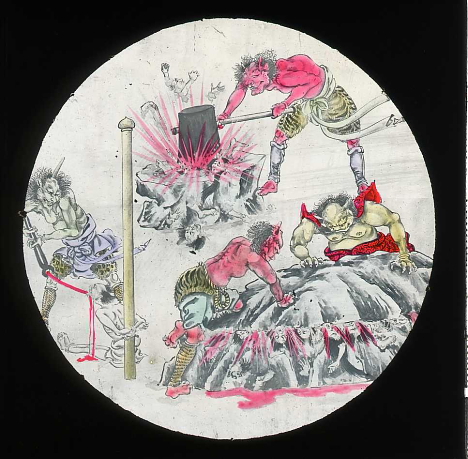
Hell [+]
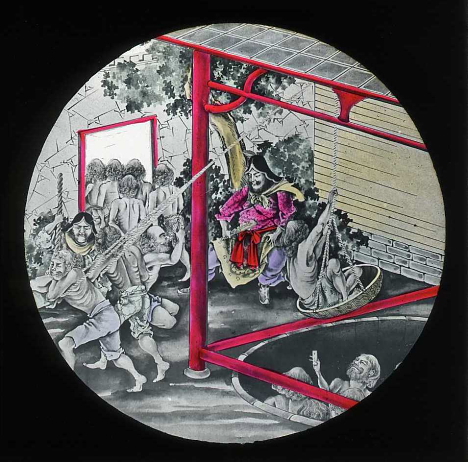
Hell [+]
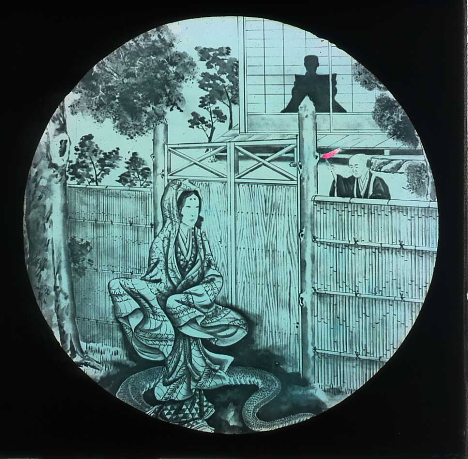
Snake woman [+]
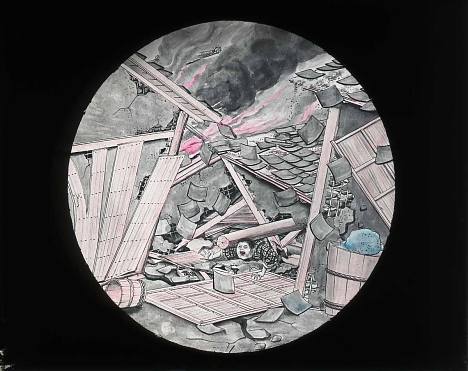
Earthquake [+]
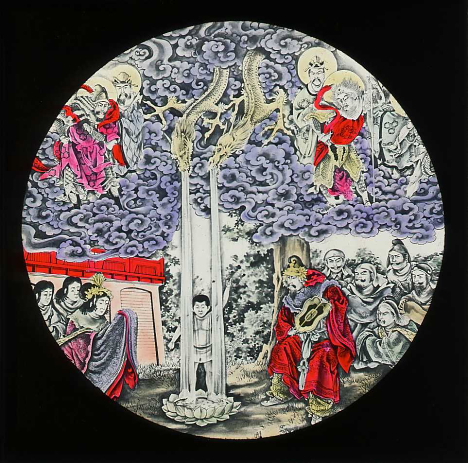
Buddhist story [+]
[UHM Magic Lantern Slides Collection via ephemera assemblyman]
Electric transformer boxes painted with the silhouettes of Ultraman monsters can be seen on the streets of Sukagawa (Fukushima prefecture), the hometown of sci-fi special effects master Eiji Tsuburaya.
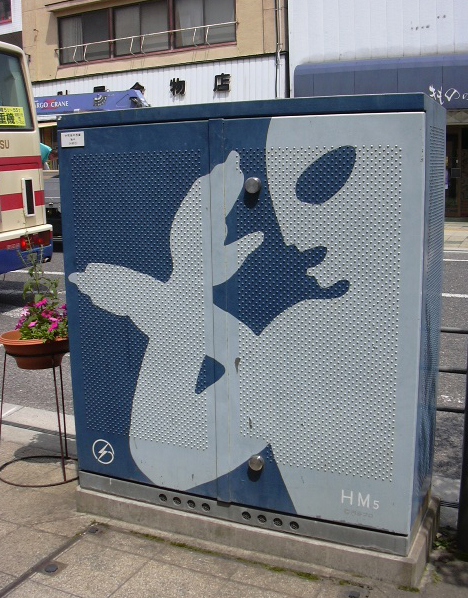
Ultraman [photo]
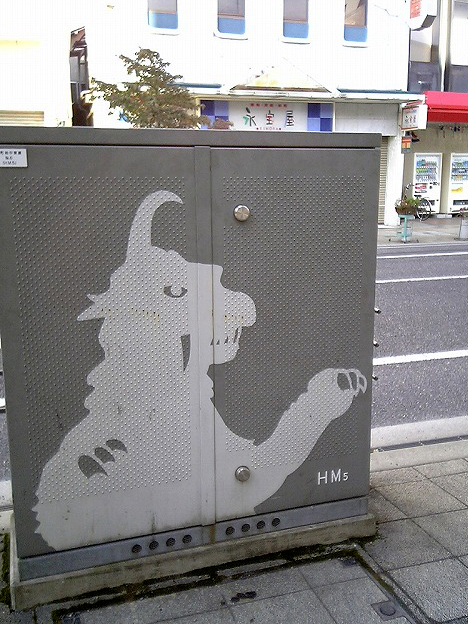
Gomess [photo]
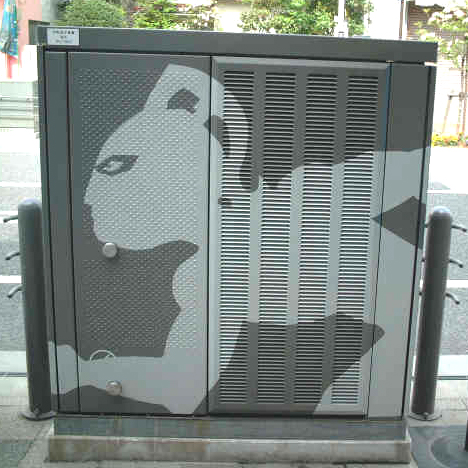
Ultra Seven [photo]
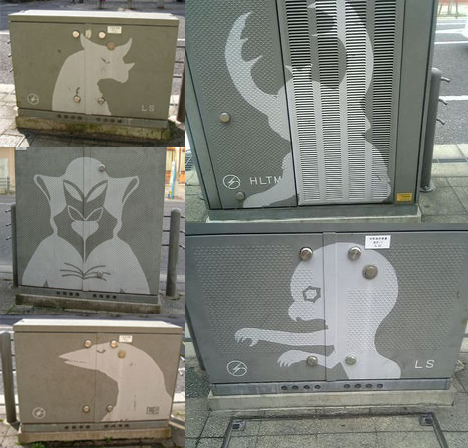
Clockwise from top-right: Antlar, Guts Seijin, Telesdon, Mephilas, Gomora [photo]
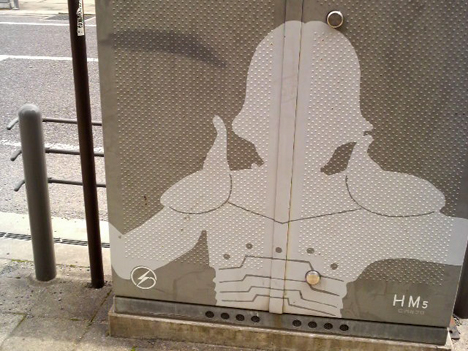
Borg Seijin [photo]
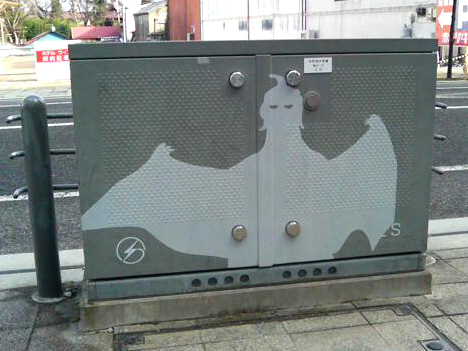
Pegira [photo]
Interactive media artist Mio I-zawa's "mechanical tumor" is a quivering hunk of fleshy, organic-looking material that expands and contracts depending on the amount of stress your computer is experiencing.
+ Video
Equipped with a series of motors and pneumatic actuators, the mechanical tumor pulsates gently when the CPU load is low. When the CPU load is high, the tumor's air compressor is activated, causing the lump of flesh to inflate.
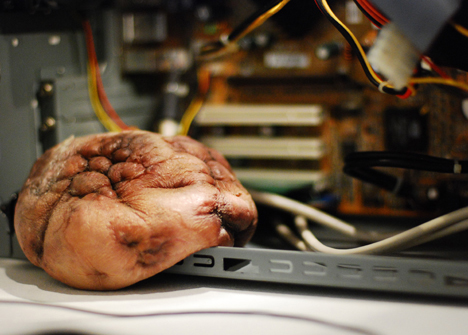
The size of the tumor fluctuates according to the CPU utilization rate, giving the user a very tangible reading of the computer's stress level.
* * * * *
Other biologically inspired interactive devices by Mio I-zawa include "external heart," a squishy latex heart on wheels that beats and rolls around in sync with the user's pulse...
...and "elastic cell," a system of 46 soft pulsating cells that react to human touch in a complex, lifelike way.
[Link: Mio I-zawa]
Here are a few samples of Japanese graphic design featured in the "Design X" special anniversary edition of IDEA magazine, 1995.
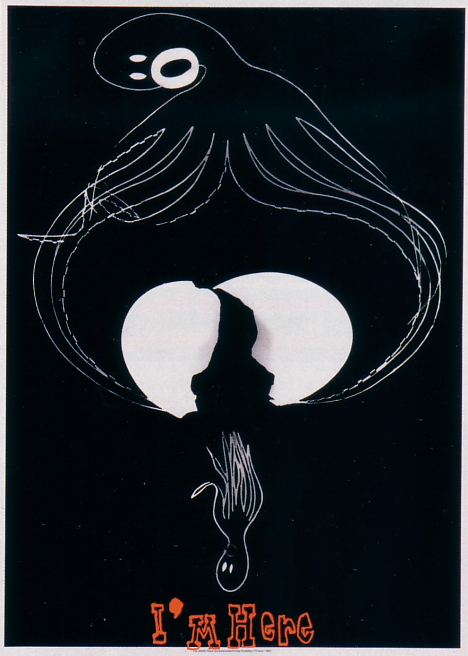
"I'm Here" poster, Katsuhiko Shibuya [+]
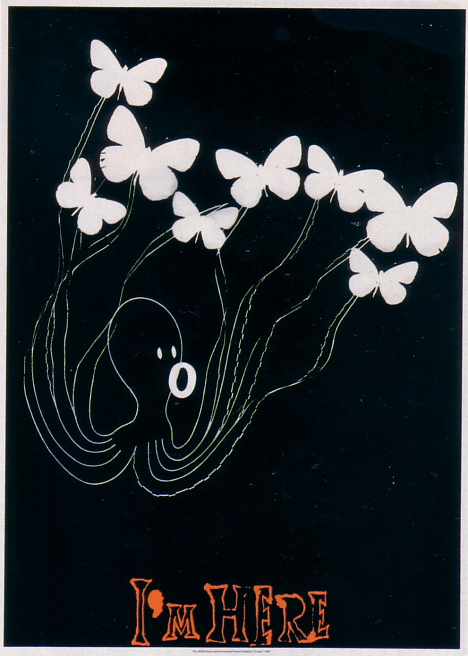
"I'm Here" poster, Katsuhiko Shibuya [+]
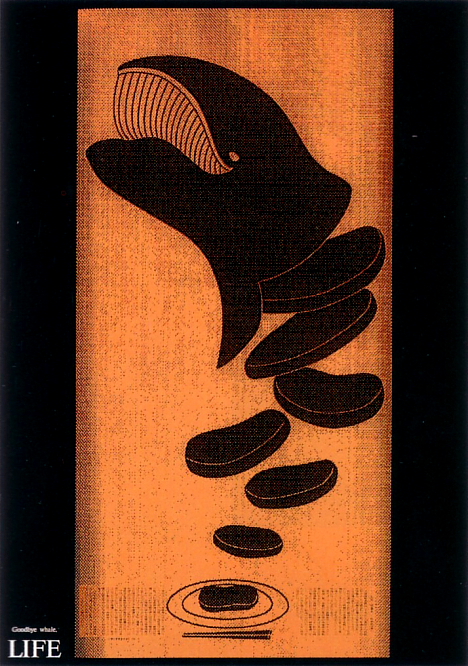
Poster for "Life" exhibition, Mamoru Suzuki, 1994 [+]
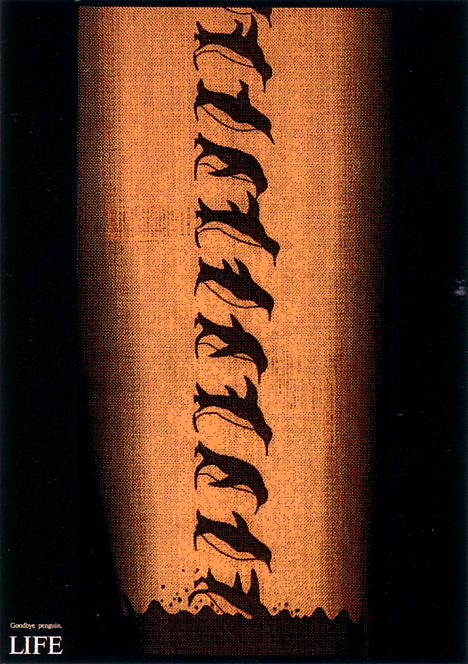
Poster for "Life" exhibition, Mamoru Suzuki, 1994 [+]
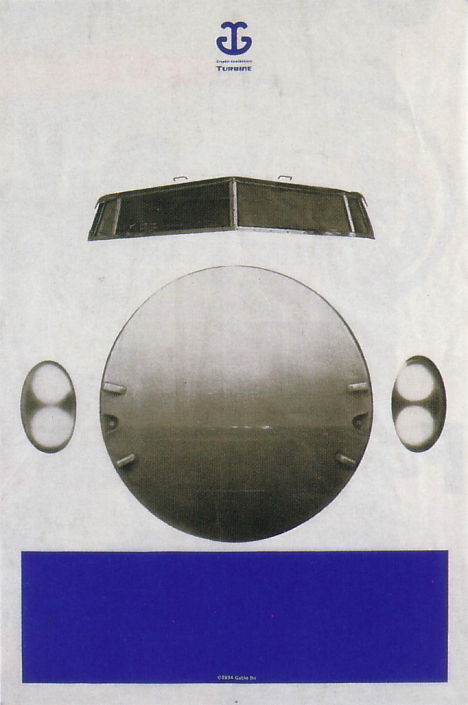
Garbage bag design, Gento Matsumoto, 1994 [+]
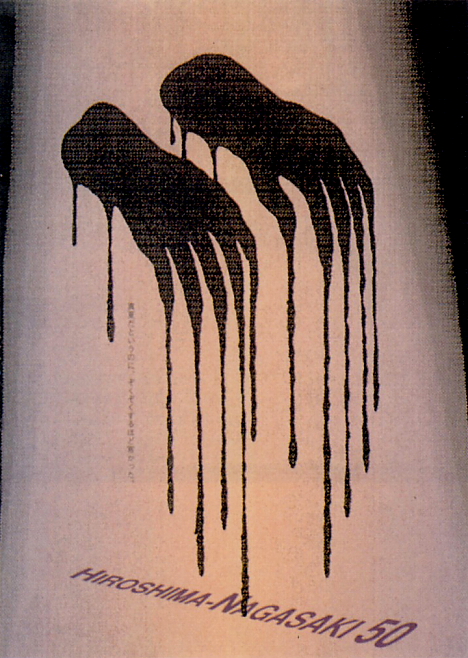
"Hiroshima-Nagasaki 50" poster for JAGDA exhibit, Mamoru Suzuki, 1995 [+]
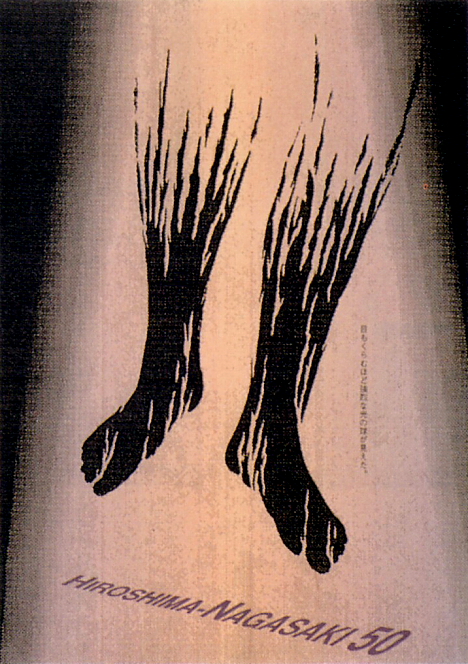
"Hiroshima-Nagasaki 50" poster for JAGDA exhibit, Mamoru Suzuki, 1995 [+]
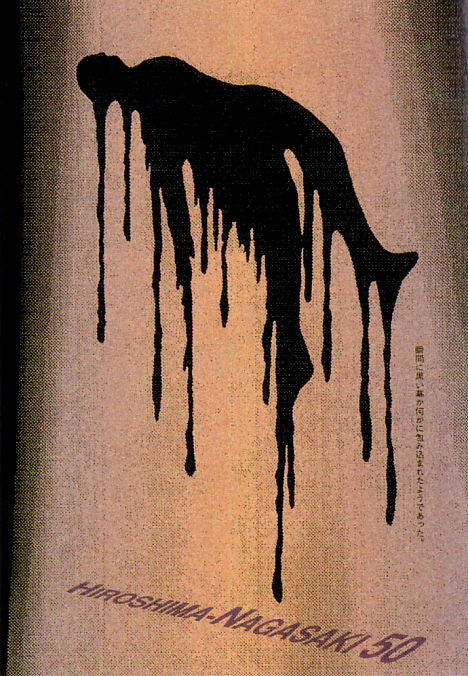
"Hiroshima-Nagasaki 50" poster for JAGDA exhibit, Mamoru Suzuki, 1995 [+]

Iconova - Portrait of Towa Tei, Keiji Itoh, 1994 [+]
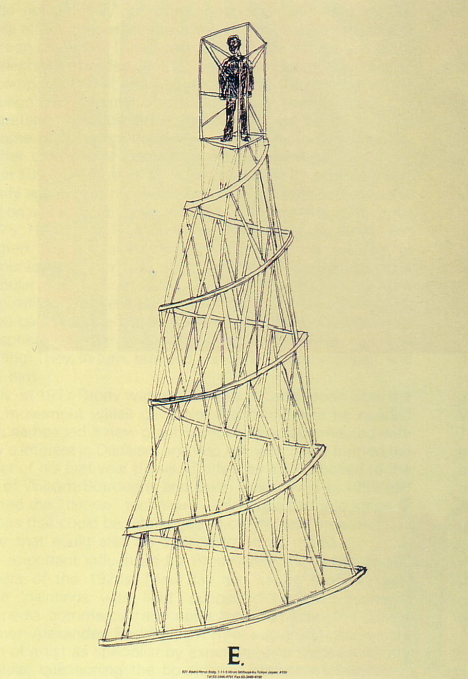
Poster for E Company, Tatsuo Ebina, 1993 [+]
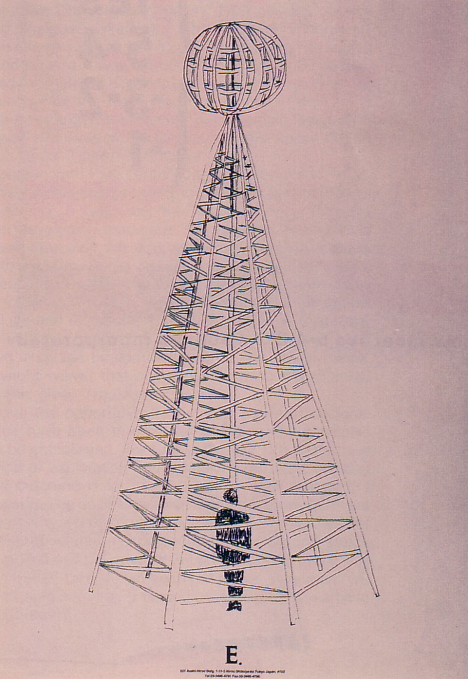
Poster for E Company, Tatsuo Ebina, 1993 [+]
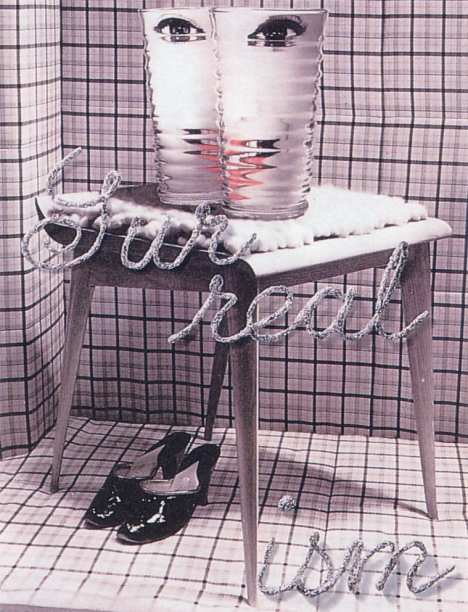
Editorial design for Hanatsubuki magazine, Katsuhiko Shibuya [+]
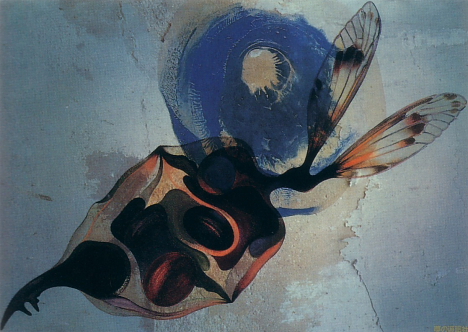
Poster for Yume-No-Yuminsha theatrical troupe, Noriyuki Tanaka, 1989 [+]
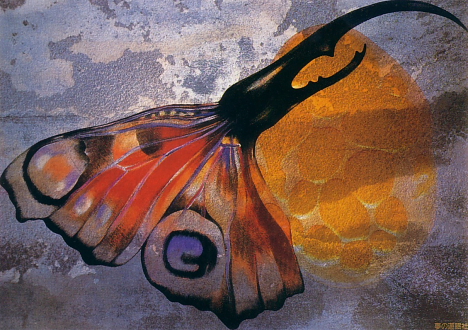
Poster for Yume-No-Yuminsha theatrical troupe, Noriyuki Tanaka, 1989 [+]
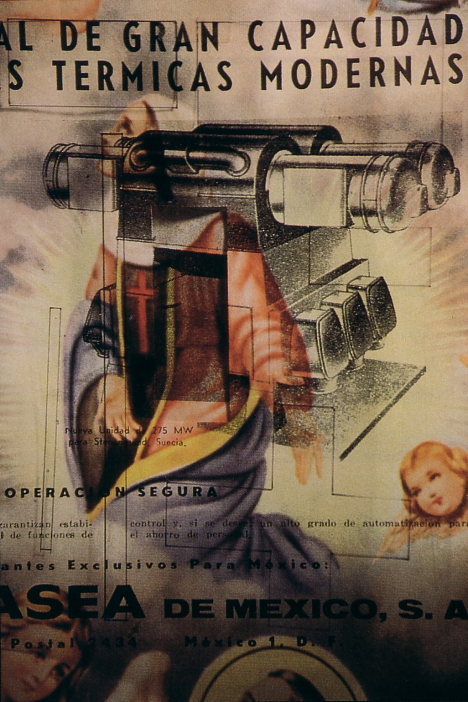
"Life/Elements" poster for "Life" exhibition, Keiji Itoh, 1994 [+]
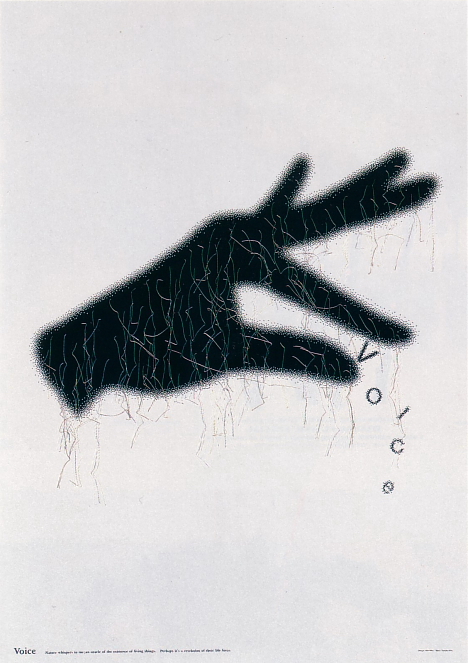
Voice, Ken Miki, 1993 [+]
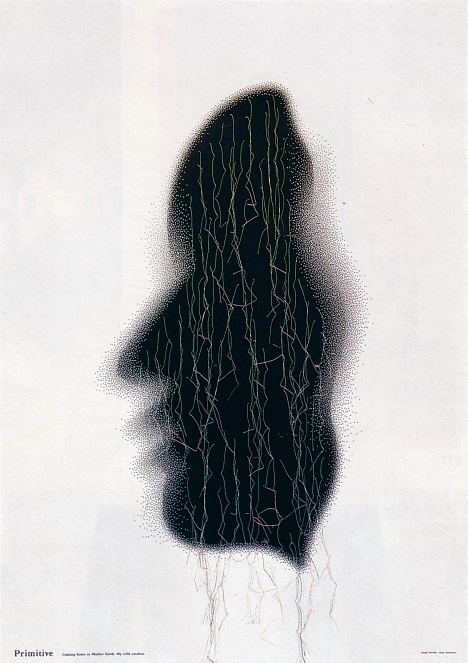
Primitive, Ken Miki, 1993 [+]
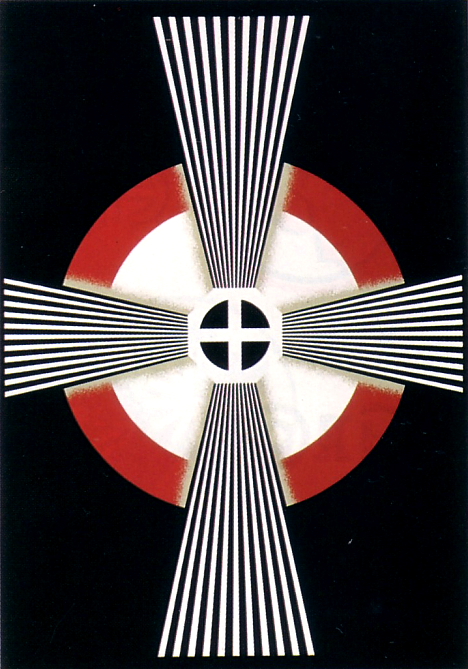
Delicate Technology, Ichiro Higashiizumi, 1991 [+]
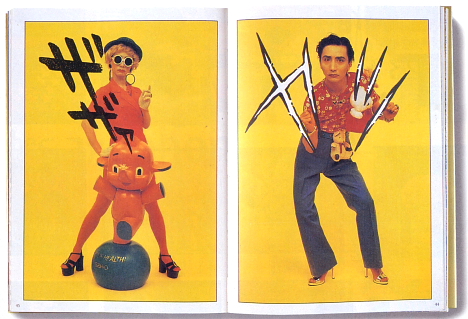
Editorial design for "Dress-up Vol.1," Noriyuki Tanaka, 1994 [+]
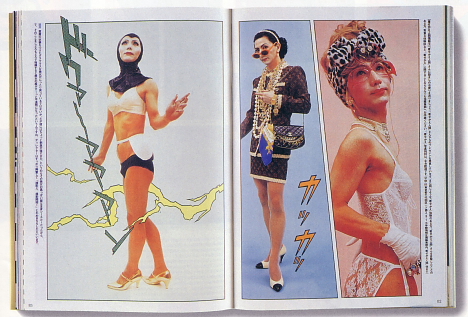
Editorial design for "Dress-up Vol.1," Noriyuki Tanaka, 1994 [+]
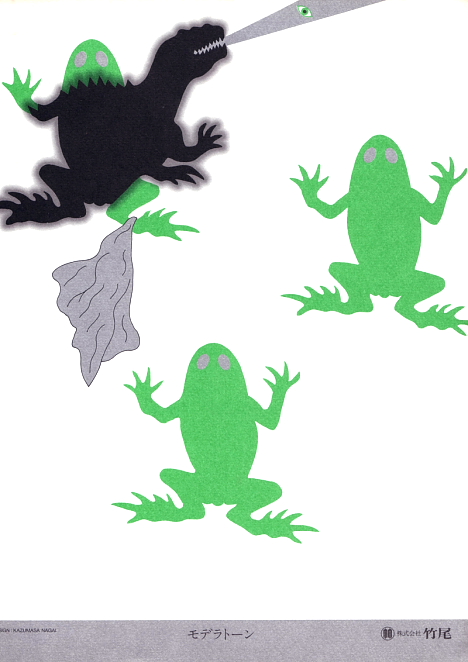
Modera Tone, Kazumasa Nagai, 1995 [+]
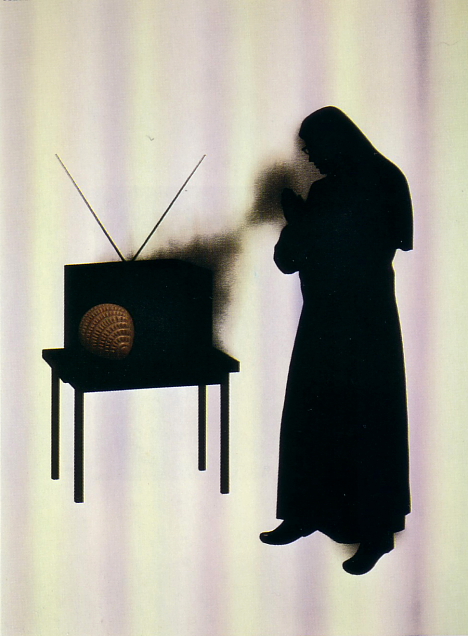
Godiva advertising poster, Osamu Fukushima, 1992 [+]
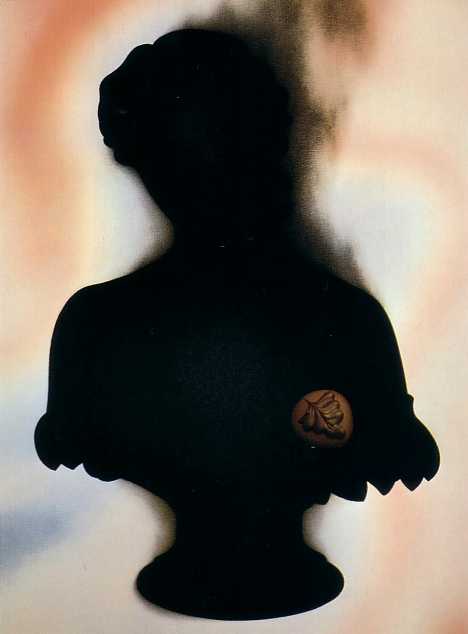
Godiva advertising poster, Osamu Fukushima, 1992 [+]
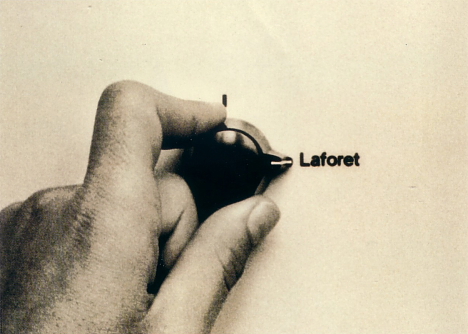
Laforet advertising poster, Takuya Ohnuki, 1991 [+]
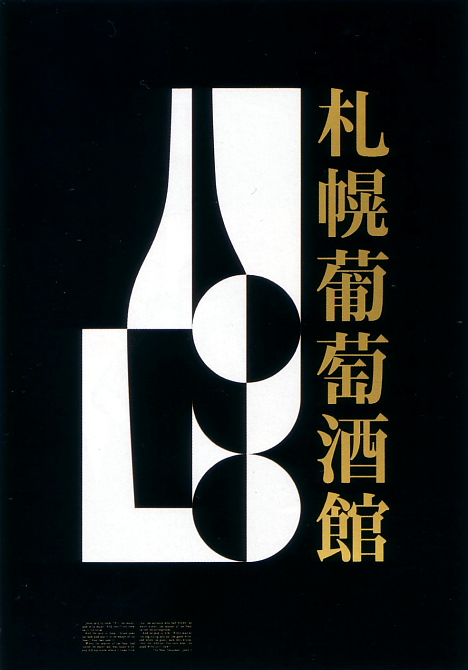
Poster for Sapporo wine museum, Kotaro Hirano [+]
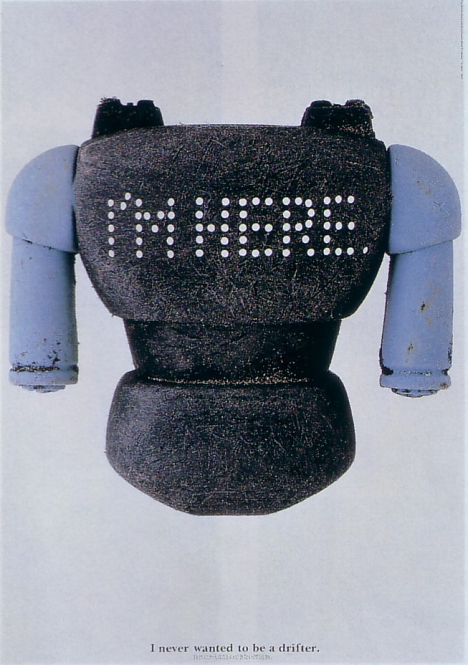
Poster for "Life" exhibition, Osamu Fukushima, 1992 [+]
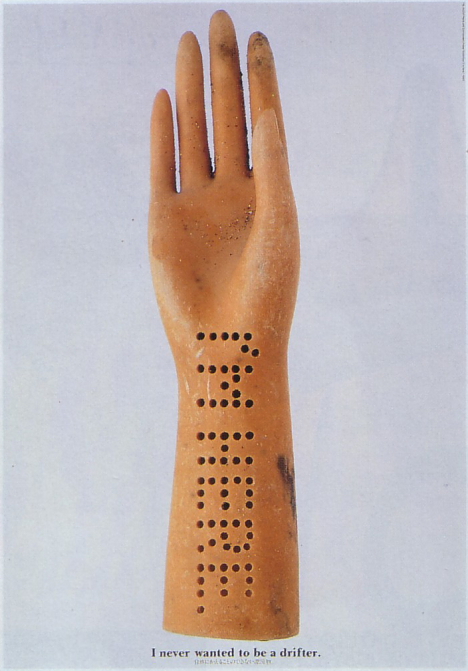
Poster for "Life" exhibition, Osamu Fukushima, 1992 [+]
In the 1960s and 1970s, Japan saw an explosion in the popularity of sonosheets -- cheap, flexible phonograph records printed on thin sheets of vinyl. Widely available from a variety of publishers, the most popular sonosheets featured theme music from TV anime, manga and tokusatsu, and they often came packaged inside booklets featuring colorful artwork. The sonosheet boom was short-lived, though -- many companies went under as the market became flooded in the 1970s, and the phenomenon all but disappeared by the 1980s. Here is a small sample of the vast array of sonosheet cover art from that era.
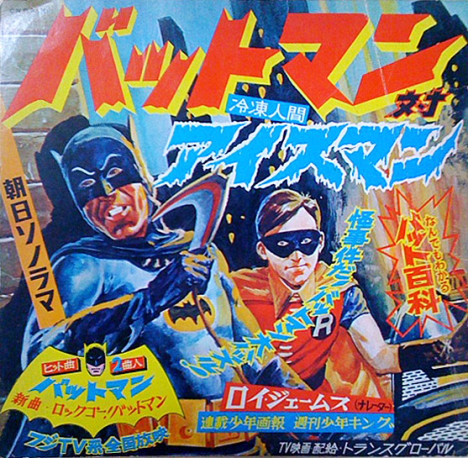
Batman vs. Iceman
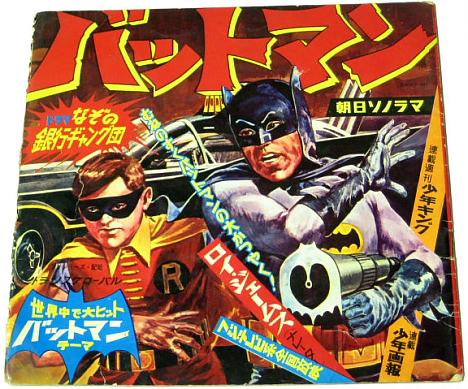
Batman (front cover) [+]
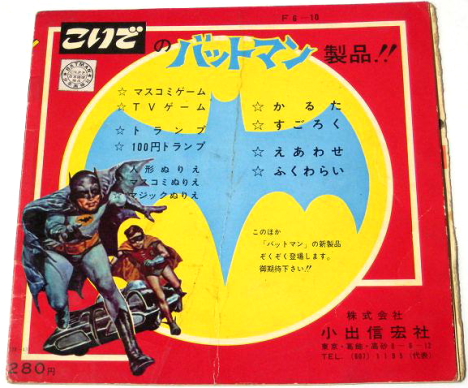
Batman (back cover) [+]
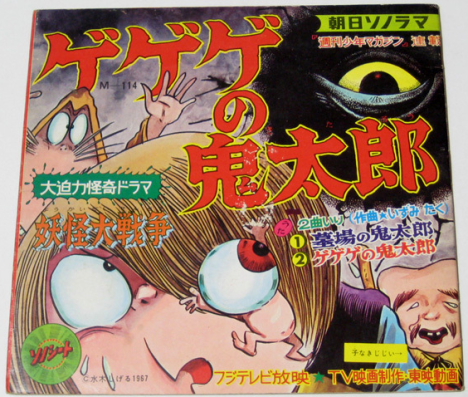
GeGeGe no Kitaro (front cover) [+]
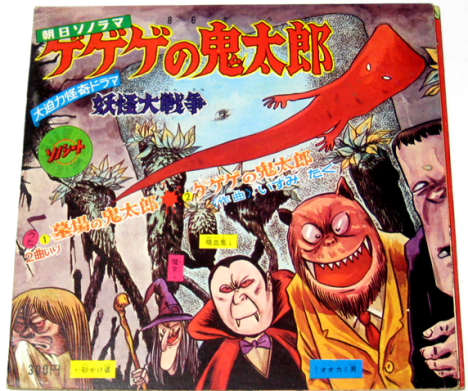
GeGeGe no Kitaro (back cover) [+]
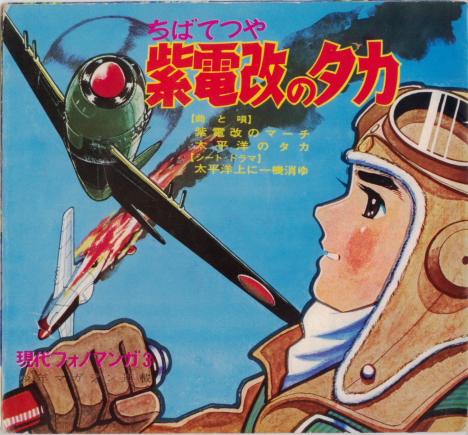
Falcon of Shidenkai [+]
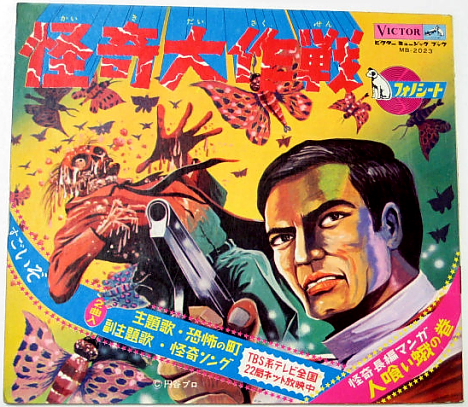
Kaiki Daisakusen (front cover) [+]
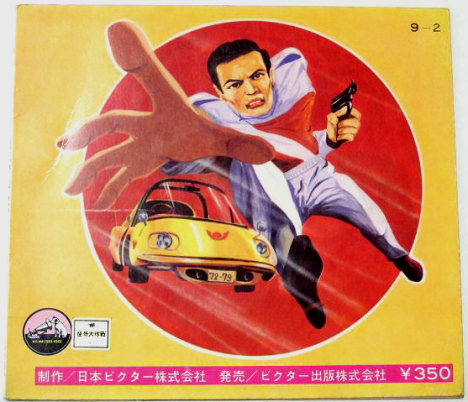
Kaiki Daisakusen (back cover)
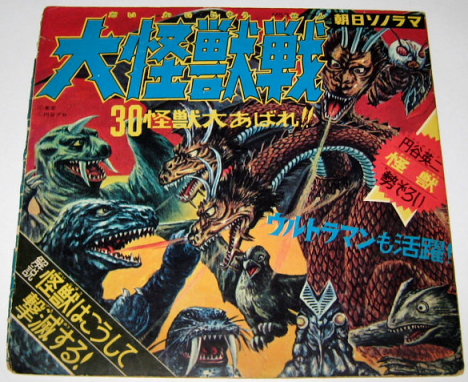
Daikaij?sen
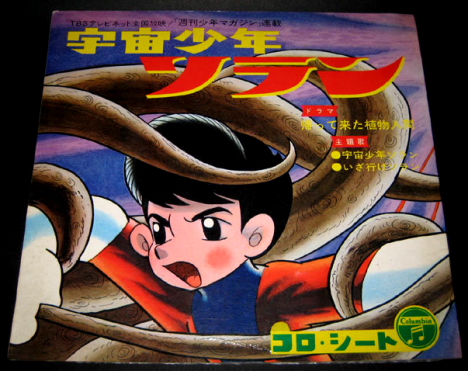
Space boy Soran [+]
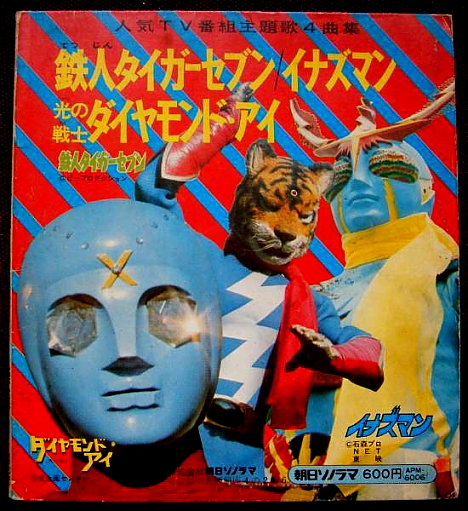
Tetsujin Tiger Seven/ Inazuman/ Diamond Eye
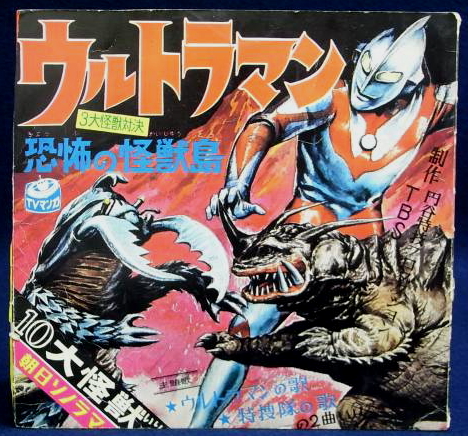
Ultraman (front cover)
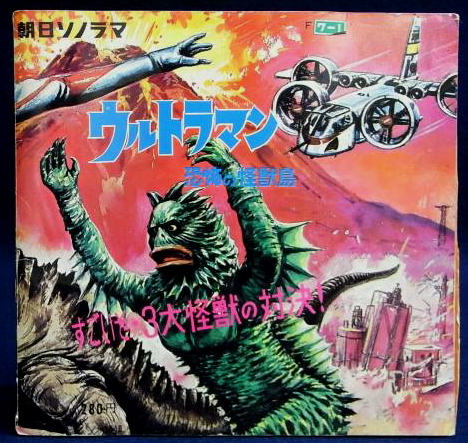
Ultraman (back cover)
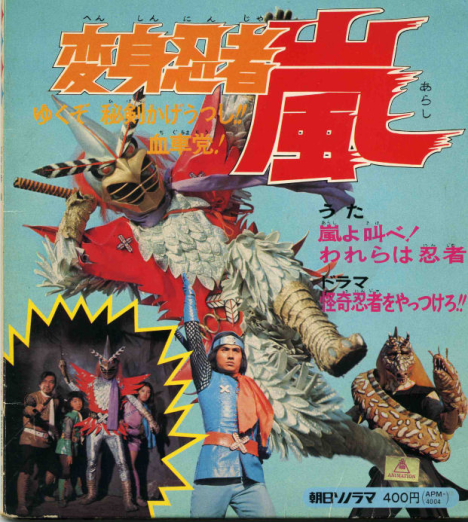
Henshin Ninja Arashi
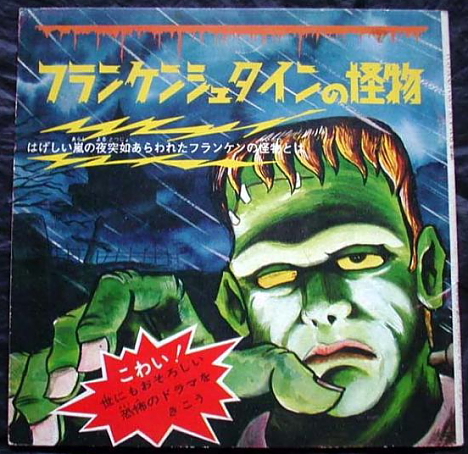
Frankenstein [+]
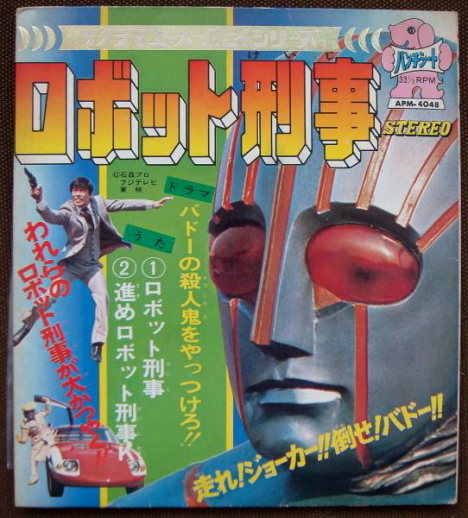
Robot Detective (front cover)
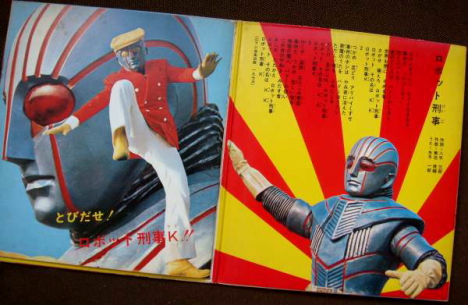
Robot Detective (inside) [+]
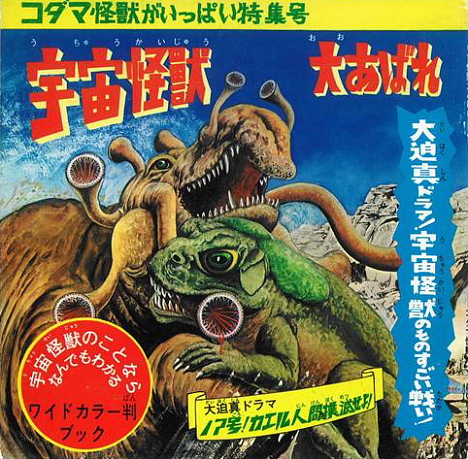
Space Monsters
[More]
Post-apocalyptic artist Yanobe Kenji has constructed an animatronic fire-breathing dragon boat for the ongoing Aqua Metropolis festival in Osaka.
+ Video
Named "Lucky Dragon," the 15-meter (49-ft) long aluminum cruise boat is outfitted with a 7-meter (23-ft) tall mechanical dragon that moves its neck and wings, spits fire and water, and flashes glowing red eyes. The boat is scheduled to entertain onlookers with periodic fire-breathing performances in the local waterways (Okawa river and Dotonbori canal) until October 12.
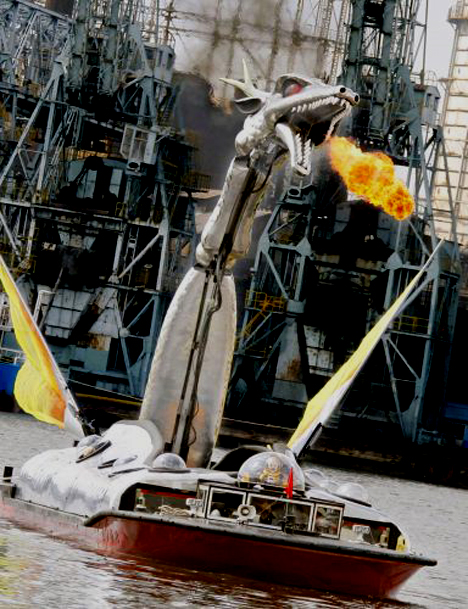
Lucky Dragon spits fire at Suminoe shipyard, September 5
The vessel is named after the infamous Lucky Dragon No.5 (Daigo Fukuryu Maru), a Japanese fishing boat that was exposed to fallout from a US nuclear weapons test on Bikini Atoll in 1954. Yanobe, a native Osakan, hopes Lucky Dragon will encourage people to think about peace while sparking the local economy.
[Source: Mainichi]
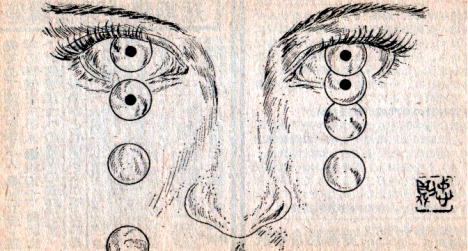
[+]
In 1975, graphic artist Tadanori Yokoo produced hundreds of pen and ink drawings for Genka ("Illusory Flowers"), a historical novel by Harumi Setouchi that recounts the struggles of Tomiko Hino, the wife of shogun Yoshimasa Ashikaga (1435-1490). The fanciful illustrations, which do not appear to directly reflect the content of the story, were published along with the novel in a long series of installments in the Tokyo Shimbun newspaper.
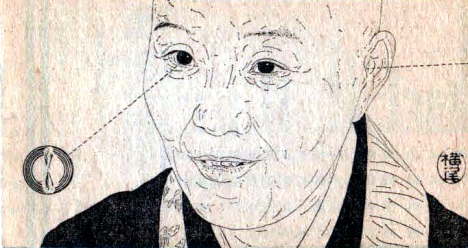
[+]
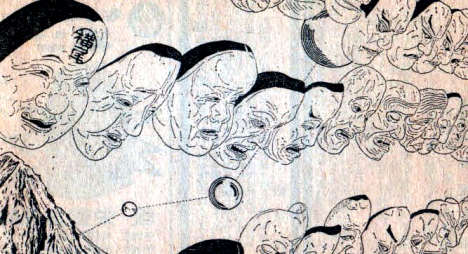
[+]
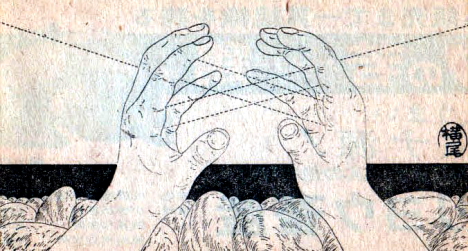
[+]
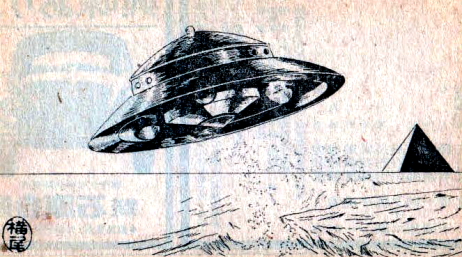
[+]
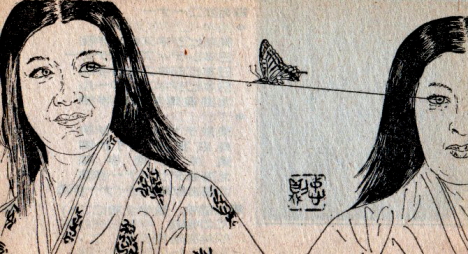
[+]
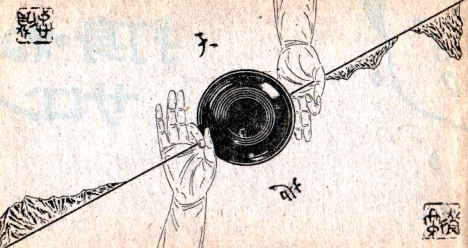
[+]
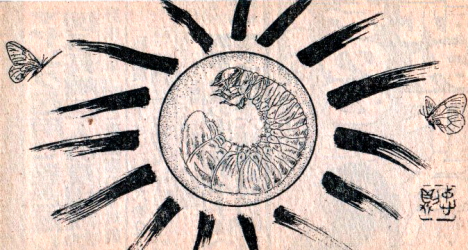
[+]
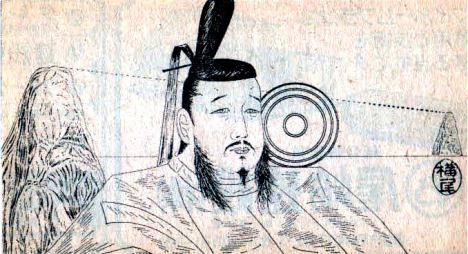
[+]
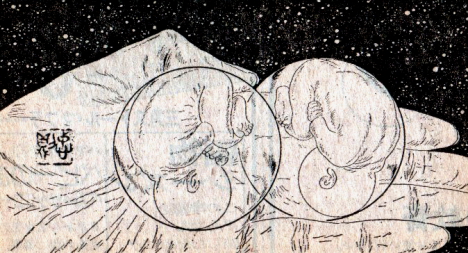
[+]
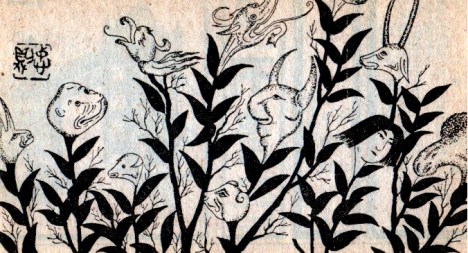
[+]
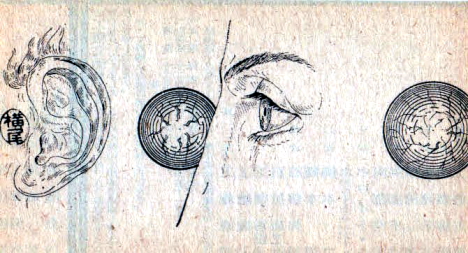
[+]
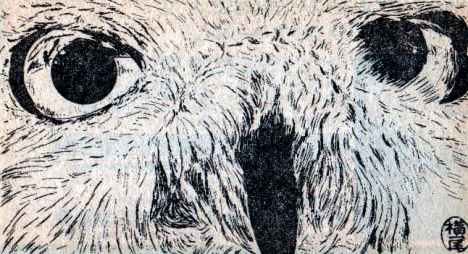
[+]
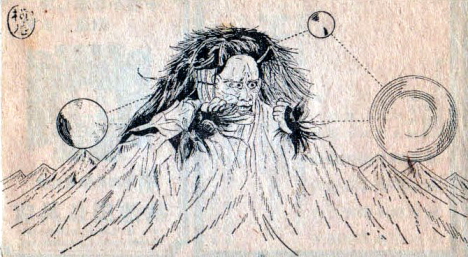
[+]
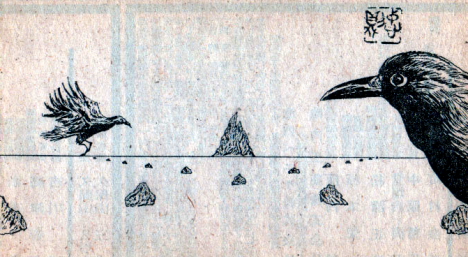
[+]
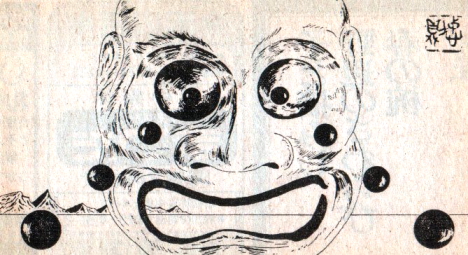
[+]
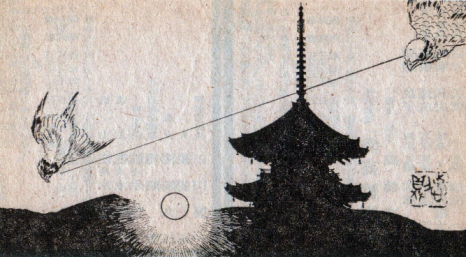
[+]
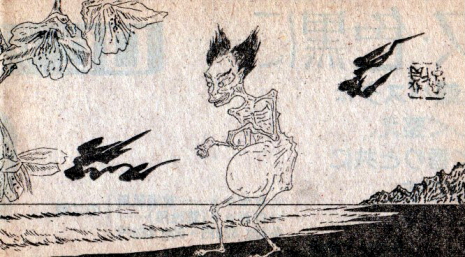
[+]
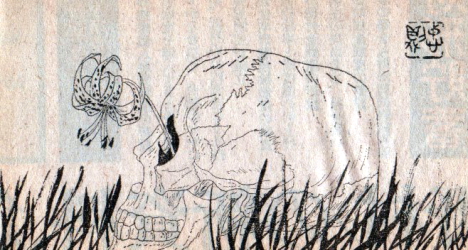
[+]
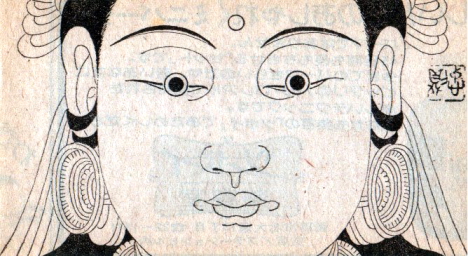
[+]
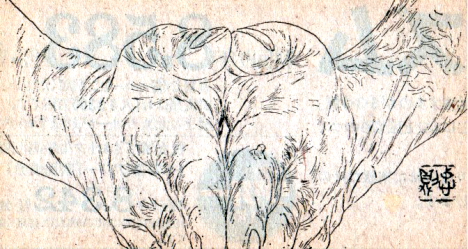
[+]
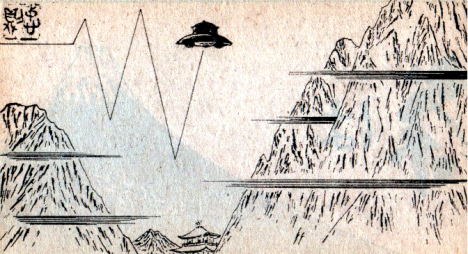
[+]
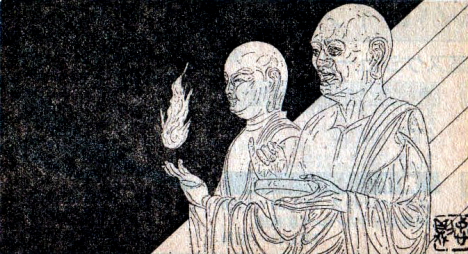
[+]
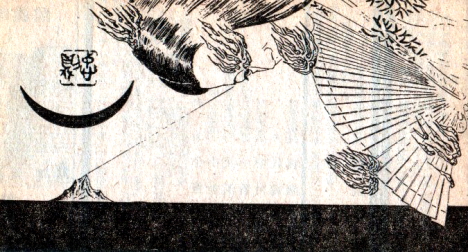
[+]
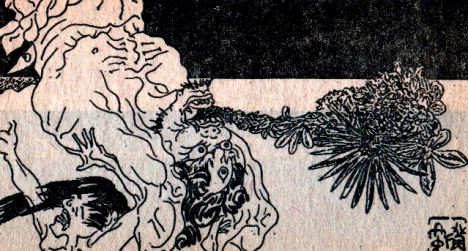
[+]
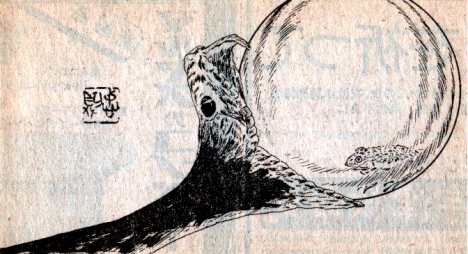
[+]
This is just a small sample of the work. For 350+ more, see hiroyasu-tangerine (16 pages): 1, 2, 3, 4, 5, 6, 7, 8, 9, 10, 11, 12, 13, 14, 15, 16.
[Via: @ColinPeters, @jaypea_aitken, @assemblyman_eph, The Cabinet of the Solar Plexus]